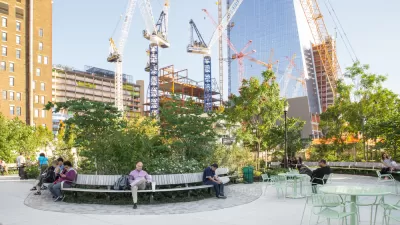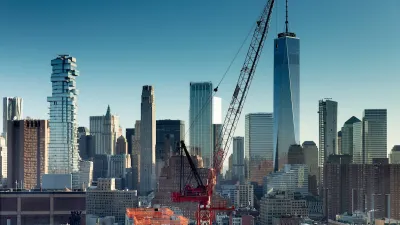New York City Mayor Bill de Blasio has set a lofty goal of creating or preserving 200,000 units of affordable housing in New York City. How can the mayor's team deliver on that promise?

Mayor Bill de Blasio recently chose his leadership team to spearhead the goal of creating or preserving 200,000 units of affordable housing in New York City.
His appointees—Gary Rodney, President of the New York City Housing Development Corporation, Vicki Been, Commissioner of the Department of Housing Preservation and Development, and Shola Olatoye, Chairwoman of the New York City Housing Authority—are all seasoned affordable housing professionals with great sensitivities to the affordable housing crisis in New York City. Although the creation of more affordable housing in New York City will be crucial to the city’s future, these new appointees will have a difficult time achieving the mayor’s goal.

Rental vacancy rates in New York City are at historic lows, and the average rental rate in Manhattan exceeds $3,000. In the last decade, the city lost more than 190,000 units of rent regulated housing and 385,000 units of affordable rental units according to the New York City Housing and Vacancy survey. The high demand from the rich and super rich has incentivized developers to create luxury rental and condominium housing instead of affordable housing. Clearly, there is an acute need for affordable housing in New York City.
Various studies predict New York City will reach 9,000,000 persons by 2025. New York City added 1.5 million people in the last 15 years. The population of the city increased from 7,000,000 in 1990 to 8,400,000 in 2014. Adding another 500,000 persons in ten years is not only reasonable but also probable.
Given those market and demographic pressures, the mayor’s goal of more affordable housing is laudable and needed, but the tools to create more affordable housing will be hard to come by. The New York City Housing Authority (NYCHA) has perennial budget deficits and a huge backlog of deferred maintenance issues at its buildings. The former NYCHA commissioner, John Rhea, was vilified in the media over the growing backlog of repairs and capital improvements. The former Mayor Bloomberg tried to raise funds by selling or leasing excess land owned by NYCHA to private developers. The current administration has nullified these plans but has not identified any new ways to raise funding. Finally, the waiting list for NYCHA housing remains large and the U.S. Department of Housing and Urban Development (HUD) has not provided funding for new Section 8 housing vouchers.
The Department of Housing Preservation and Development (HPD) and the New York City Housing Development Corporation (HDC) are the two main agencies responsible for the creation of affordable housing in New York City. HPD continues to labor under diminishing revenue from New York State and the HUD. Besides diminishing capital funding, land prices in New York City continue to increase as the local economy improves. The current administration is a strong advocate for union labor and will probably support greater involvement of union labor in the creation of affordable housing. Union labor, which traditionally has been involved in affordable housing, will only increase the cost of the creation and preservation of affordable housing.
The only viable tool that New York City has to increase affordable housing is zoning. Carl Weisbrod, the current head of City Planning, spearheaded the city’s efforts in the 1980s to transform Time Square from a seedy neighborhood of pornographic movie theaters to the center of tourism in New York City. He succeeded. Hopefully, he will bring the same dynamic skills to solve the affordable housing crisis in New York City.
Many outlying neighborhoods in New York City in the outer boroughs have zoning only suitable for the creation of 1-4 family homes. However, these neighborhoods have active commercial corridors with rich public transportation options that could easily support more dense housing. The city should provide significant zoning bonuses to support the creation affordable in these districts. Selective upzoning will 1) provide new land for the creation of affordable housing, 2) lower the price of land in these neighborhoods only for affordable housing developers, and 3) support commercial activities in these neighborhoods by creating more dense housing and adding more households to these outlying neighborhoods.
Ideally, three to five currently low density neighborhoods in the outer boroughs would be targeted for selective upzoning. Upzoning would only occur on commercial corridors and only be granted for the creation of affordable housing. If the mayor intends to reach his goal of creating or preserving 200,000 units of housing in ten years, he will need selective upzoning and more dense housing options to achieve this goal.
The traditional tools for the creation of affordable housing in New York City, such as cheap land and plentiful local subsidy funds, no longer exist. Upzoning, only for affordable housing, will lower the price of land for affordable housing developers and create more areas suitable for multifamily development in New York City.

Alabama: Trump Terminates Settlements for Black Communities Harmed By Raw Sewage
Trump deemed the landmark civil rights agreement “illegal DEI and environmental justice policy.”

Planetizen Federal Action Tracker
A weekly monitor of how Trump’s orders and actions are impacting planners and planning in America.

Why Should We Subsidize Public Transportation?
Many public transit agencies face financial stress due to rising costs, declining fare revenue, and declining subsidies. Transit advocates must provide a strong business case for increasing public transit funding.

Understanding Road Diets
An explainer from Momentum highlights the advantages of reducing vehicle lanes in favor of more bike, transit, and pedestrian infrastructure.

New California Law Regulates Warehouse Pollution
A new law tightens building and emissions regulations for large distribution warehouses to mitigate air pollution and traffic in surrounding communities.

Phoenix Announces Opening Date for Light Rail Extension
The South Central extension will connect South Phoenix to downtown and other major hubs starting on June 7.
Urban Design for Planners 1: Software Tools
This six-course series explores essential urban design concepts using open source software and equips planners with the tools they need to participate fully in the urban design process.
Planning for Universal Design
Learn the tools for implementing Universal Design in planning regulations.
Caltrans
Smith Gee Studio
Institute for Housing and Urban Development Studies (IHS)
City of Grandview
Harvard GSD Executive Education
Toledo-Lucas County Plan Commissions
Salt Lake City
NYU Wagner Graduate School of Public Service





























